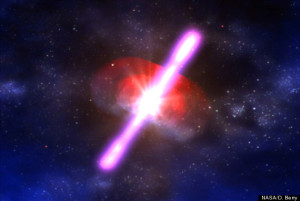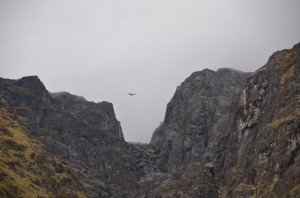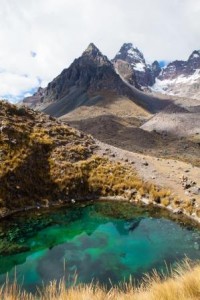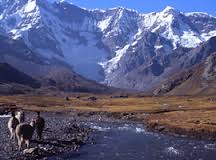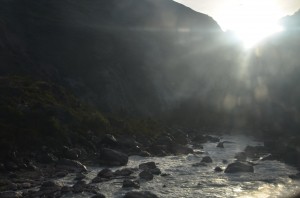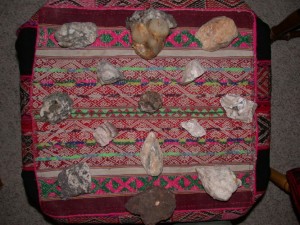Blog
The Transcendental Concept of the Subtle Body
Added January 15th, 2014 to Shamanic Practiceby Deborah Bryon
Jung said that psychic healing occurs through numinious archetypal experience – by working with symbols and images. Similar to Jung’s use of symbols, Andean shamans – or paqos – use ceremony and rituals to create vessels that contain archetypal energy, and provide a means of differentiating from the experience in order to make meaning. Rituals also create psychic space to move around in that serve as a bridge or gateway between the conscious and the collective unconscious. In shamanism, the intention is to move beyond symbolism to the energetic level of preverbal experience. In the deeper realms of shamanic nonverbal experience, the image is no longer relevant and drops away.
Growing up in this culture, we tend to see nature and the world around us through our lens of ordinary perception. However, by shifting our conscious awareness and paying attention energetically, it is possible to experience the earth as alive – as an energetic body with its own consciousness. In Journey to Ixtlan (Castaneda, 1972), Don Juan described the experience of seeing the world around us energetically as “feeling with your eyes.”
An example of this practice occurs in the epic film Star Wars. In Star Wars, Obi-Wan tells Luke repeatedly to “feel the force,” and instructs Luke Sky Walker to use “the force” to develop as a Jedi warrior. In our collective culture, the idea that it is necessary to use “the force” to become a Jedi warrior is accepted as true (hence the success of the movie), but the actual practice and experience of becoming a Jedi warrior is far more rare. The act of knowing moves beyond the description of belief into a state of experiencing by being in it.
In his identity transition from anthropologist to sorcerer, Castaneda wrote (1998),
“I felt that I was truthfully cut in two: some part of me was not shocked at all and could accept any of Don Juan or Don Genaro’s acts at face value. However, there was another part of me that flatly refused; it was my strongest part. My conscious assessment was that I had accepted Don Juan’s sorcery description of the world merely on an intellectual basis, while my body as a whole entity refused it, thus my dilemma. But then, over the course of the years my association with Don Juan and Don Genaro I had experienced extraordinary phenomena and those had been bodily experiences, not intellectual ones (p.45).”
Both Obi-Wan and Don Juan are describing the process Jung called shifting into awareness through the somatic unconscious or the subtle body. Jung described the subtle body as, “(being) beyond time and space, beyond our grasp, per definition; the subtle body is a transcendental concept, which cannot be expressed in terms of our language or our philosophical views, because they are all inside time and space. Moving deeper into this in-between space or field is an aspect the veil in which concepts of images and symbols cease to be applicable.
According to Jung, the dialogue that takes place in this realm occurs in the form of images, rather than words – by understanding the archetype through working with symbols. I would add that although the images may be the means of expressing and communicating the experience of the subtle body, the actual experience of the subtle body occurs energetically within the body at a level deeper than the symbolic level. To understand something symbolically is a cognitive operation of the mind – and to understand something with the mind requires separating from the experience. To understand something fully with the body entails one to be with it. Being with something energetically involves entering a state of fluidity, while having an awareness through the formation of a symbol necessitates being outside the experience. To see something symbolically and describe it requires being outside of it.
Finding Your Own Voice in the Wilderness
Added December 31st, 2013 to Energetic Connectionby Deborah Bryon
To find one’s own voice requires hearing one’s own voice – and listening. It may be felt deep within the body, or sensed as a “knowing” or “rightness.” It may come in the form of stillness, or be experienced in a flow of effortless momentum – having the wind at your back or being carried down stream by the current.
Hearing our own voices is generally easier when we are somewhere in nature – rather than struggling to decipher sounds emanating from our souls underneath a continual stream of loud traffic or in the midst of constant chatter in an anxious, over-stimulated crowd.
Yet it can also be hard to hear one’s own voice in the wilderness feeling terribly alone before learning how to listen. Following one’s own voice is not convenient because it may require bumping up against what we think we want and need – or what others think we should want or need. We may choose NOT to hear to our own voices when it tells us something that we do not want to know, when it requires us to sit in the emptiness of “not knowing” – when the stakes feel to high or the pain becomes too intense to bear. These times of deep soul searching, are what Jung referred to as the “night sea journey,” and shamans call dismemberment.
Jung described the process of learning to follow one’s own voice as individuation – a journey to our deepest Self. It is the journey of orphans and widows because the path is often lonely. Yet, during times when we are able to remain steady, when we listen to our inner voices and do not abandon ourselves by turning away from what we are hearing, we may discover a deeper connection with the living world of energy surrounding us.
I have learned from the people I work with that there is comfort in living with the integrity that comes from listening to the voice of one’s soul. There can be strength in the process of purification that comes from staying in relationship with what we know as our individual truth. Staying connected to ourselves holds the potential for us to discover profound meaning. If we listen we may realize that we are not alone.
Pachamama: The Great Mother Spirit of the Earth by Adolfo Ttito Condori
Added November 22nd, 2013 to Inca shamanby Deborah Bryon
Pachamama is a feminine spirit that governs the universe. They are different tribes, different areas, and different animals, which are called Pachamama Kuma. Pachamama is the over-seeing spirit, the primary feminine spirit of the earth. The Pachamama Kumas are the subset of the feminine spirits in places of the earth. Pachamama, is the big over-lighting feminine spirit that watches over the Pachamama Kuma. There are feminine places on the land that have their own spirit, and these would be a Pachamama Kuma, or a Pachamamita, or Santa Tierra, which means “Saint of the Earth.” For example, if you want to invoke universally, you would say Pachamama Kuma or Pachamamas. Pachamama is general. It is the big over lighting spirit.
So as we are planting seeds, we are doing something good – and that shows that we have a good heart. It is not about giving lots of money or things. It is what you have at the moment, what you feel is right. That is showing compassion and love. You are feeling this. So be very careful with the Pachamama. She is watching all of your actions. It is true. That is the way it is. There have been some times when I have forgotten this. I have too many things. My mind is busy and I have been distracted doing things. There is always a time when we find ourselves distracted. So at the beginning of the path, there tends to be lots and lots of distractions. However, as we, as we do this work, the distractions become smaller and smaller.
Pachamama is in all places. She does many deeds, gives us many gifts, many blessings as well. She gives us our clothing because she takes care of the animals. She gives us water because through her comes the water and all the spiritual elements are connected to the waters too. Pachamama is all things. She is always behind us protecting us, taking care of us. She is sad or preoccupied at times because of the contamination we have created, because of the disasters that are happening in the world. These disasters are a result of the contamination. That is because for every period of time, purification is important. So that is why we say lightning is part of purification, the storms and lightning is part of her spirit – so soft and pure. She is always clean.
What is contaminating Pachamama? Her cape is what is getting the contamination – a part of her physical body, energetic body. Spiritually, the Pachamama is always; always strong. She does not need to change. She does not need to be cleaned. So humanity is contaminating the house of the Pachamama and we ourselves can clean that bit-by-bit, taking care of the earth and cleaning the natural world or universe. Showing our brothers and sisters how to do that as well, – how to take care of the natural world. So in other places of the world there is always emphasis on taking care of the Pachamama. (Conversation, 2012).
Workshops on Andean Medicine and Upcoming trips to Peru
Added November 16th, 2013 to Events, Trips to Peruby Deborah Bryon
Preliminary Schedule
Winter/Spring 2014 (Dates TBA)
Sacred Ceremonial Pilgrimage with Andean Altomesayoq in Capital Reef Utah
Led by the Altomesayoq Adolfo Tito Condori. Facilitated by Deborah Bryon Ph.D., Jungian analyst, author of the books,“Lessons of the Inca Shamans: Part 1 and 2.”
Our vision has created a journey of traditional Incan shamanic training in ancient Anazazi energetic power sites with the high shaman Altomesayoq Adolfo Tito Condori. Adolfo is one of only eight altomesayoqs living in Peru today. In addition to an emersion into the practice of traditional Andean rituals, fertile space will be held in the sacred desert of Capital Reef for learning about working with the mesa medicine bundle and creative imagery from personal dream states and visions.
June 2014
Sacred Initiation Journey of the Andean Shaman in Peru : Part II Learn the Spiritual Traditions of the Incas with Altomesayoq Adolfo Tito Condori. Facilitated by Deborah Bryon, Ph.D, Jungian Analyst, author of the books “Lessons of the Inca Shamans: Parts 1 and 2.”
The Altomesayoq (high shaman) Adolfo Tito Condori and the Andean medicine people will assist us into paradigm shifts of deep knowledge and healing. This almost extinct lineage of shamans, the Altomesayoqs, have the ability to summon and materialize mountain spirits for healings, information, and rituals. Adolfo will give us direct knowledge of the experience of relationship with the Santa Tierras, the elementals of the land and the Apu hierarchy of mountain spirits. The medicine people of AKQ will share their sacred world, filled with oral traditions, supernatural beliefs, legends, and colorful myths. They will teach us enter into their animistic world to understand qualities of energy, and healing modalities. On our journey we will travel across high mountain roads, to visit sacred ice-clad peaks and emerald lagoons. We will camp under the radiant stars of the night sky of the southern hemisphere. Master ceremonialists will teach the ancient Andean rituals deepening our vision and connection in munay, right relationship with the powerful spirits of the land.
August 10 ‐ 23, 2014
The Way of the Untamed Mystery: The Amazon and the Incas
Led by Jose Luis Herrera, facilitated by Deborah Bryon, Ph.D, Jungian Analyst, author of the books, “Lessons of the Inca Shaman:Part 1 and 2,” and Carol Dearborn Artist, President Emeritus of the Sufficiency Foundation
This is one of the most dramatic, challenging and ecologically diverse journeys put together. We immerse ourselves into the technologies of healing and Cosmo-vision of two great geographies, the Amazon Rainforest and the mighty Andes Mountains The journey takes us into the deep jungles of the southern Amazon to temples in the clouds perched on holy mountains in Cusco, Machu Picchu, and the colossal Holy Mountain Ausangate. The goal of this journey is to experience the ceremonies, traditions, and cosmology of Master Jaguar and Mountain Shamans.
October 2014
Sacred Initiation Journey of the Andean Shaman in Peru: Part I
Learn the Spiritual Traditions of the Incas with Altomesayoq Adolfo Tito Condori. Facilitated by Deborah Bryon, Ph.D, Jungian Analyst, author of the books “Lessons of the Inca Shamans: Parts 1 and 2.”
The Altomesayoq (high shaman) Adolfo Tito Condori and the Andean medicine people will assist us into paradigm shifts of deep knowledge and healing. This almost extinct lineage of shamans, the Altomesayoqs, have the ability to summon and materialize mountain spirits for healings, information, and rituals. Adolfo will give us direct knowledge of the experience of relationship with the Santa Tierras, the elementals of the land and the Apu hierarchy of mountain spirits. The medicine people of AKQ will share their sacred world, filled with oral traditions, supernatural beliefs, legends, and colorful myths. They will teach us enter into their animistic world to understand qualities of energy, and healing modalities. On our journey we will travel across high mountain roads, to visit sacred ice-clad peaks and emerald lagoons. We will camp under the radiant stars of the night sky of the southern hemisphere. Master ceremonialists will teach the ancient Andean rituals deepening our vision and connection in munay, right relationship with the powerful spirits of the land.
What is Psychoanalysis?
Added November 3rd, 2013 to Psychoanalysisby Deborah Bryon
Psychoanalysis is a comprehensive, theoretical framework, which when applied to a treatment process, consists of an intensive verbal, therapeutic relationship between an analyst and an analysand which aims for symptom relief, emotional depth, and personal integration. The psychoanalytic treatment process includes, but is not limited to, the recognition of unconscious processes and conflicts, the significance of developmental influences, and the impact of resistances, defenses, transference, and countertransference phenomena. Treatment is enhanced by an understanding developed in the analyst’s training and personal analysis of unconscious manifestations, such as dreams, slips of the tongue, fantasies, and day dreams. Psychoanalytic technique varies in relation to theoretical orientation. (APAP, 2013)
Keeping Visions Alive with Sacred Imagery
Added October 26th, 2013 to Shamanic Practice, Uncategorizedby Deborah Bryon
Similar to psychotherapists, shamans believe that healing the past occurs through feeling in our hearts and bodies. Telling (and retelling) our recollection of the past or reliving our dreams in any given moment can connect us with the feeling. At deep levels of profound energetic collective experience, a faint thread of conscious awareness is held by being with the feeling. Following the feeling of energetic experience is the only means of connecting with the experience at a pre-conscious level. This is the because these states exist at a preverbal and pre-image level – and feeling states are the only channel available to us at deeper levels. Once an energetic experience can be felt, it can be recapitulated – and processed.
Inner symbols charged with psychic energy often become accessible in dreams, synchronistic events instilled with meaning, and through shamanic vision. The process of re-membering by circumambulating around a symbol or image is a top-down approach that often eventually becomes grounded in the body in an “a-ha” moment. From this feeling state, symbolic imagery may emerge that provides structure that can contain the energetic experience.
After returning home after one trips to Peru, for a period I dreamt of snakes. I had dreams of snakes lying by my feet at my computer as I wrote and of carrying them around in my pockets. Snakes became my companions in the inner world. In one of my dreams, a powerful snake split the floor open beneath me. In another dream, I was taking energy from a large snake in the otherworld and giving it to baby snakes in this world that lived in caves. The snake dreams I experienced provided my psyche with a metaphor for working with and assimilating the powerful energy of Amaru associated with the numinous experience.
The length of time we carry the charge of the afterglow of numinous experience in our luminous body depends on our willingness to engage with our vision of the experience and to keep it alive in our minds, hearts, and bodies. Engaging in this way offers a means of entering a dialogue with non-ordinary reality. The constant element in each of these processes is that connection with the experience occurs and is maintained through the body, first somatically, then as emotional feeling, and then in the form of imagery. The sequence of steps involved in the recapitulation process corresponds to experiencing energy through the belly, the heart, and then through the mind.
Tending to Kausay by Deborah Bryon, Ph.D.
Added October 17th, 2013 to Books, Inca shamanby Deborah Bryon
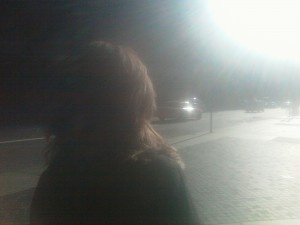 Paqos live their lives by tending to kausay and learning from the abundance in nature. Kausay is the building block of shamanism and Incan medicine. It is the fuel, life force, and the energy of creation, experienced in the body as a vibration, and in the heart as a feeling of universal love. In the Mind, kausay is often seen as an intense light, or experienced as clarity, bringing sense of all-knowing wisdom. It is also experienced in altered states of ecstasy when paqos enter into the spirit world of energy. Medicine people learn to source, or draw the life energy of kausay from Pachamama because Pachamama is constant and always there.
Paqos live their lives by tending to kausay and learning from the abundance in nature. Kausay is the building block of shamanism and Incan medicine. It is the fuel, life force, and the energy of creation, experienced in the body as a vibration, and in the heart as a feeling of universal love. In the Mind, kausay is often seen as an intense light, or experienced as clarity, bringing sense of all-knowing wisdom. It is also experienced in altered states of ecstasy when paqos enter into the spirit world of energy. Medicine people learn to source, or draw the life energy of kausay from Pachamama because Pachamama is constant and always there.
Sometimes a manifestation of kausay comes as an unexplainable event that as Westerners, we would identify as “strange, weird or magic. You may remember times when you invariably experienced the flow of Kausay energy through you if you think about it. A time when you felt very alive and “in the flow,” a time when things were clicking.
The expression of kausay occurs by being in ayni, in an open reciprocal relationship with Pachamama. What is taken from the land is returned to the land in gratitude so that it can be born again. Everything in nature, and all living things, occurs in the order of “right relationship,” or kausay pacha. Everything comes from and returns to Pachamama.
According to Inca cosmology, being in ayni (“right relationship”) comes as an expression of munay (unconditional, universal love) with the collective. In Inca shamanism, the definition of “collective” is much broader than in modern Western culture. Instead of using the term to refer to “mass culture” and society, shamans use the word collective to speak of the energetic relationship existing between all living things. For paqos, this consists of plants, animals, humans, and anything belonging to the physical and/or energetic realm of the natural world.
EXERCISE I: BUILDING KAUSAY IN CONNECTION WITH PACHAMAMA
Find a comfortable place to sit, cross-legged in a meditation position. If you are seated on a chair, make sure your feet are placed firmly on the ground. Take a few deep breaths, inhaling and exhaling from your belly and close your eyes. As you exhale, feel yourself sinking deeper into your body, moving further with each breath into a receptive and peaceful state. As your attention gradually shifts more fully into what you are experiencing in your core, your breathing will become easy and relaxed, falling into a gentle rhythm. As you continue breathing from your belly, feel your awareness dropping even farther into your interior, as you are sensing through your body.
Now, using your intention imagine a star of light located in the deepest part of your interior and visualize it growing, becoming stronger and larger. Using your intent, imagine feeling the energetic rays reaching down through your legs, through the bottoms of your feet, and deep into the earth. Again, using your intention, allow the rays of light to carry your focus, moving deep into the earth with the light.
From the place of sensing deep within the earth, sense your connection with the earth and with all living things. Feel yourself held and nourished in the loving and powerful presence of Pachamama, as the energy exchange begins to strengthen and expand between you and the earth. Giving the Pachamama rays of light emanating from the light star in your belly and in exchange receiving the nourishing energy from Pachamama in an exchange of ayni, of right relationship
Using your intention, fully receive Pachamama’s gift of energy by allowing it to move up through the bottoms of your feet, through your legs, into your belly, throughout your entire body.
You may experience Pachamama’s nourishing energy as an orange energy vibration, or as warm sunlight, or golden honey. Allow yourself to be fed by her energy, while making connection with her through the light emanating from the star in your belly. Breathe the energy in and breathe it out through exhaling, directing it back, deep into the earth.
When you feel complete, open yourself to the feeling of gratitude for Pachamama. Thank her for gift and for being present. When you are ready, in your own time, gradually bring yourself to your outer awareness and open your eyes.
(Excerpt from “Lessons of the Inca Shamans Part II:Beyond the Veil,” Deborah Bryon)
(Apu Huascaran, Excerpt from Piercing the Veil Part 2: Beyond the Veil, 2013)
Added September 18th, 2013 to Inca shaman, Uncategorizedby Deborah Bryon
Excerpt from forthcoming publication, “Lessons of the Inca Shamans, Part 2: Beyond the Veil”
Added September 13th, 2013 to Shamanic Practiceby Deborah Bryon
We have forgotten our roots and don’t know who we are becoming. The moment is who you are. It is what we are right now that matters. Even if beliefs are forgotten, the primordial identity is remembered. We’ve forgotten our primeval identity. We have the tendency to hoard. Every ten years we go into massive warfare, to deal with the “inflamed hoarding” we tend toward. In that process of metaphorically hoarding life, sometimes we wake up and feel empty, not knowing who we are, beyond the hoarding. We need to re-find the primordial identity. Who are we? This has to do with the primordial identity we have forgotten. The bottom line is that everyone should have the authority, power, & responsibility to create pathways to joy. But our cultural paradigm isolates us. We do not know what fulfillment – the healed state – means for us. Our identity resides in reawakening our lineage.
Finding a medicine coordinate gives us medicine names (not personal identity names) that have to do with vision. Through this process, we become stewards, feeders, proposing a new, happening, collective order to belong. In the material world, they are linked to career/profession. In Inca times, a blood lineage connected brothers and grandchildren. Outside the “doing” identities, historical identities of fear, etc… We are history-makers, story makers. There is no power in re-enacting old stories. Stories of creativity and love can be given to our grandchildren, to propel them into a healed state. New stories must be made, such that our grandchildren will tell them as their legacy of returning to the land. In this journey we are on, we all have the responsibility to leave behind a legacy, big or small. If it is going to be a big legacy, we must go through big rites of passage. Power is a big responsibility. Power has to do with what we leave behind. To acquire power, there are rituals, initiations, rites of passage. You invest in reciprocal effects. The process of preparation is reciprocal. One must embody a spiritual search – one denominator, common evolution. This entails a shift in own creative awareness. For life, there needs to be this process of reciprocation. The spiritual search is parallel – both are exemplars of growth. In bigger rites of passage, one is selected to become a leader. If the gift of power is given, one needs to embody it.
(Dona Alahandrina, 2011, from Lessons of the Inca Shamans Part 2: Beyond the Veil, Publication forthcoming)
Finding Quiya Stones to Build a Mesa
Added August 16th, 2013 to Inca shaman, Uncategorizedby Deborah Bryon
Paqos serve Pachamama by feeling Pachamama. This connection happens in relationship with the mesa. The mesa anchors the paqo to the earth, and as an intermediary, serves as the gateway to the spirit world through connection with kausay pacha. A mesa‘s capacity to hold power or energy is a function of the strength of the paqo’s relationship with Pachamama.
Finding a q’uiya or mesa stone is something that happens when you are in a receptive state and paying attention. It is not something that can be forced. When a stone becomes a q’uiya, it becomes a sacred object. Sometimes a q’uiya chooses us. Q’uiyas can appear suddenly in our path. They can also disappear from our mesas when our work together is complete, and it is time for us to say goodbye.
Building a mesa is an act of love, and q’uiyas – like mates – should be chosen very carefully. A q’uiya stone is a living being that becomes a member of our medicine body. Like the human form, it helps if the shape or aesthetic form of a mesa stone is unified and complete. It is important that the stone is not missing limbs; that is not chipped or with pieces missing. Mesa stones must be capable of holding energy – as well as information.
Bringing a new q’uiya into a mesa is similar to bringing a new member into a family. Everyone must get along and work together. Each q’uiya has its own location, similar to each member of a family having a seat at the dinner table. Using intention, the sacred stones are woven together to form a rich tapestry connecting our energy body to Pachamama, and the spirit world. In order for our power, or our capacity to hold energy, through the medicine body of our mesa to grow, we need to be in ayni with our q’uiyas, – and the q’uiya must be in relationship with each other. This dynamic relationship between q’uiya stones develops either as a union of opposites balancing masculine and feminine energy (yanantin), or through an alignment of similar energy (masintin).
Mesas can provide us with deep wisdom if we take the time to listen. A q’uiya stone can become an important a teacher. Each stone is imprinted with information and energy that we discover as our knowledge and understanding of the q’uiya deepens. A paqo’s relationship with a mesa is a love affair, and as in any significant intimate relationship, it requires attention in order to grow and thrive. Caring for a mesa is similar to tending to a young child – or any living being for that matter – it needs to be fed, purified, listened to, and treated with respect. We feed our mesas with love and intention, sitting with them and giving them our full attention. I have found it is easiest to connect with my mesa when I am in nature, the place where it is easiest for me to shift into communicating with the spirit world.
